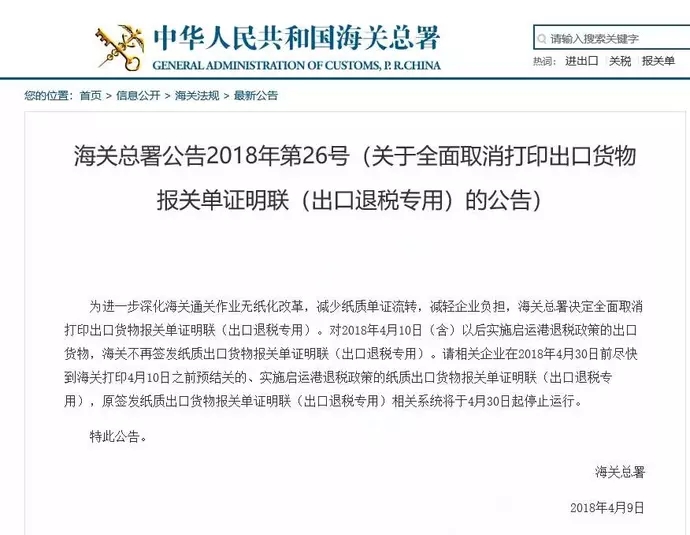On April 9, the General Administration of Customs issued an announcement stating that in order to further deepen the paperless reform of customs clearance operations, reduce the circulation of paper documents, and reduce the burden on enterprises, the General Administration of Customs has decided to completely cancel the printing of the certificate of export goods declaration (export tax rebate dedicated).

Specifically, for export goods that implement the tax refund policy at the port of departure after April 10, 2018 (inclusive), the customs will no longer issue a paper copy of the customs declaration form for export goods (exclusively for export tax refund). Relevant enterprises should go to the customs as soon as possible before April 30, 2018 to print the paper export goods declaration form certificate (for export tax refund) that was pre-cleared before April 10 and implemented the tax refund policy at the port of departure, and the paper export goods declaration form was originally issued The system related to the certification link (exclusively for export tax rebates) will cease operation from April 30.
Glossary
Paperless customs clearance means that the customs classifies import and export goods according to risk levels based on enterprise classification management and risk analysis, and uses information technology to review and collect electronic data of customs declaration forms and accompanying documents declared by enterprises online. The customs clearance operation method of tax and inspection and release.
Why implement the paperless reform of customs clearance operations?
In recent years, with the development of the global economy and the advancement of information technology, various trade documents for transactions between enterprises have undergone ingenious changes. The most notable point is the transformation from traditional paper certificates to electronic certificates. From an international perspective, many developed countries are also accelerating the pace of implementing paperless customs clearance. For example, since July 2009, the EU Customs has fully implemented electronic customs declaration, and the "EU Unified Customs Declaration Form" is submitted to the customs electronically. Japan, Singapore and other countries have realized the paperless customs clearance of most goods through the information system. Paperless customs clearance has become a common practice of customs in developed countries in the world. At the same time, the ever-increasing volume of import and export trade and limited customs supervision resources are a contradiction. Therefore, my country's active use of advanced scientific and technological means and technological achievements to promote paperless customs clearance operations is an inevitable requirement to adapt to the situation and achieve scientific development, and it is also in line with international trade practices.
Process comparison before and after paperless reform
Originally: Enterprises need to print and copy relevant documents and queue up at the customs clearance site to deliver the documents. After the customs audit, it is necessary to manually sign and approve the customs declaration form. After the review is completed, the enterprise is notified to obtain the paper documents, and the enterprise can only pick up or ship the goods at the supervision place and port terminal after obtaining the relevant release certificate. Since the enterprise's resident, document review operation site and cargo storage site are often not in the same place, it causes a lot of inconvenience to go back and forth.
After the paperless reform: Enterprises only need to declare electronic data without submitting paper documents. After the customs release, the electronic release information will be sent to the enterprise and the storage site of the goods at the same time. And port terminal or regulatory place and a lot of on-site queuing time. At the same time, after the reform, enterprises do not need to print paper accompanying documents for on-site presentation procedures, which also effectively saves paper document printing, storage costs, manpower and transportation costs for on-site document presentation.
Chronicle of events in paperless reform of customs clearance operations
On July 4, 2012, at the mobilization and deployment meeting of the national customs to further promote the reform of customs clearance operations, the customs comprehensively promoted the reform of classified customs clearance and started the pilot reform of paperless customs clearance.
On August 1, 2012, 12 customs offices including Beijing, Tianjin, Shanghai, Nanjing, Hangzhou, Ningbo, Fuzhou, Qingdao, Guangzhou, Shenzhen, Gongbei and Huangpu officially launched the national paperless customs clearance pilot reform.
On April 11, 2013, the General Administration of Customs issued the "Announcement on Matters Concerning Deepening the Pilot Work of Paperless Customs Clearance Reform".
On December 4, 2015, the General Administration of Customs issued an announcement, deciding to carry out paperless modification and cancellation of import and export declarations throughout the country. From March 1, 2016, the customs will no longer handle the modification and cancellation of customs declaration forms in paper form, except for technical reasons such as computers and network systems that cannot be modified or revoked through the pre-entry system.
From February 3, 2017, the General Administration of Customs decided to expand the scope of paperless enterprises applicable to customs clearance operations to all credit-rated enterprises.
On April 8, 2018, the General Administration of Customs decided to completely cancel the printing of the certificate copy of the customs declaration form for export goods (exclusively for export tax rebates).